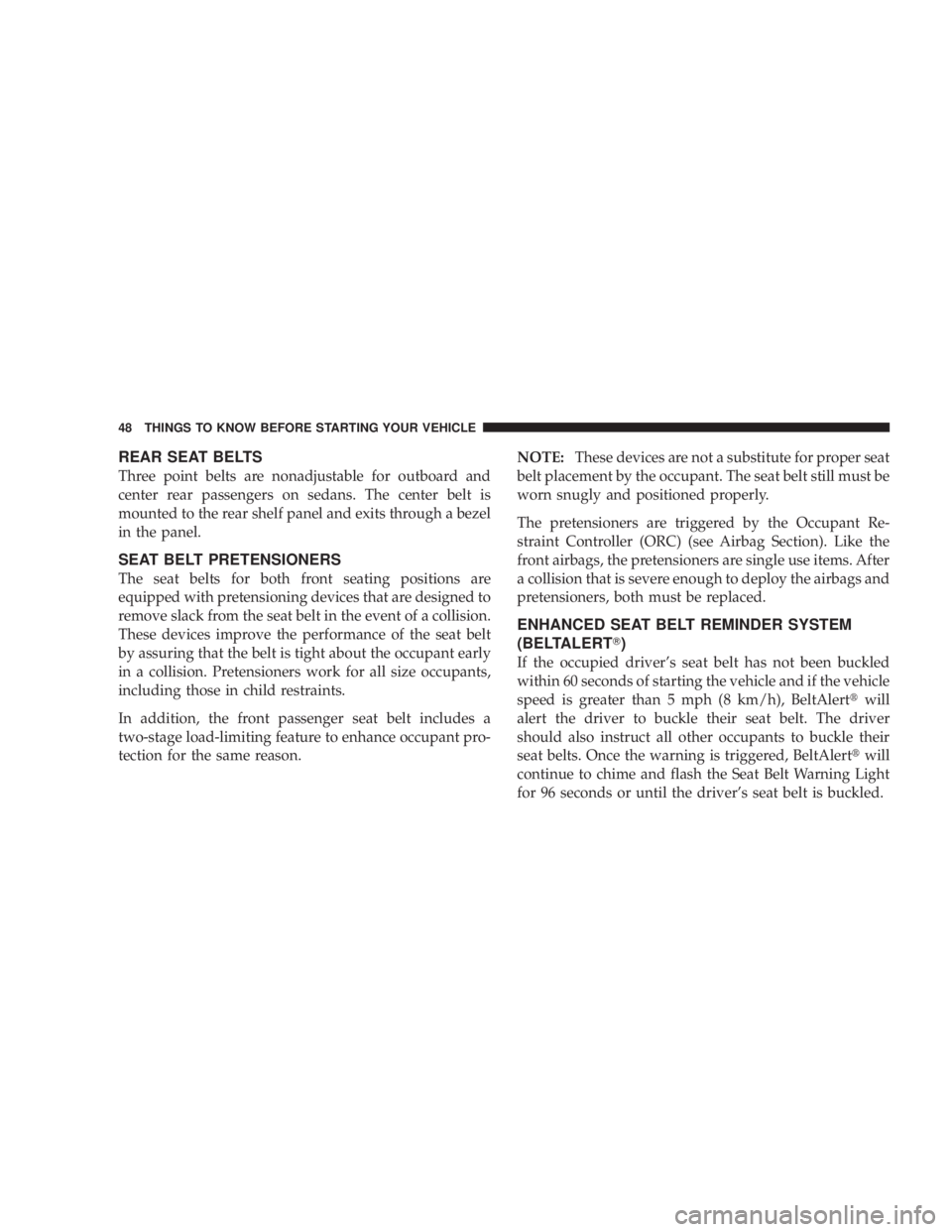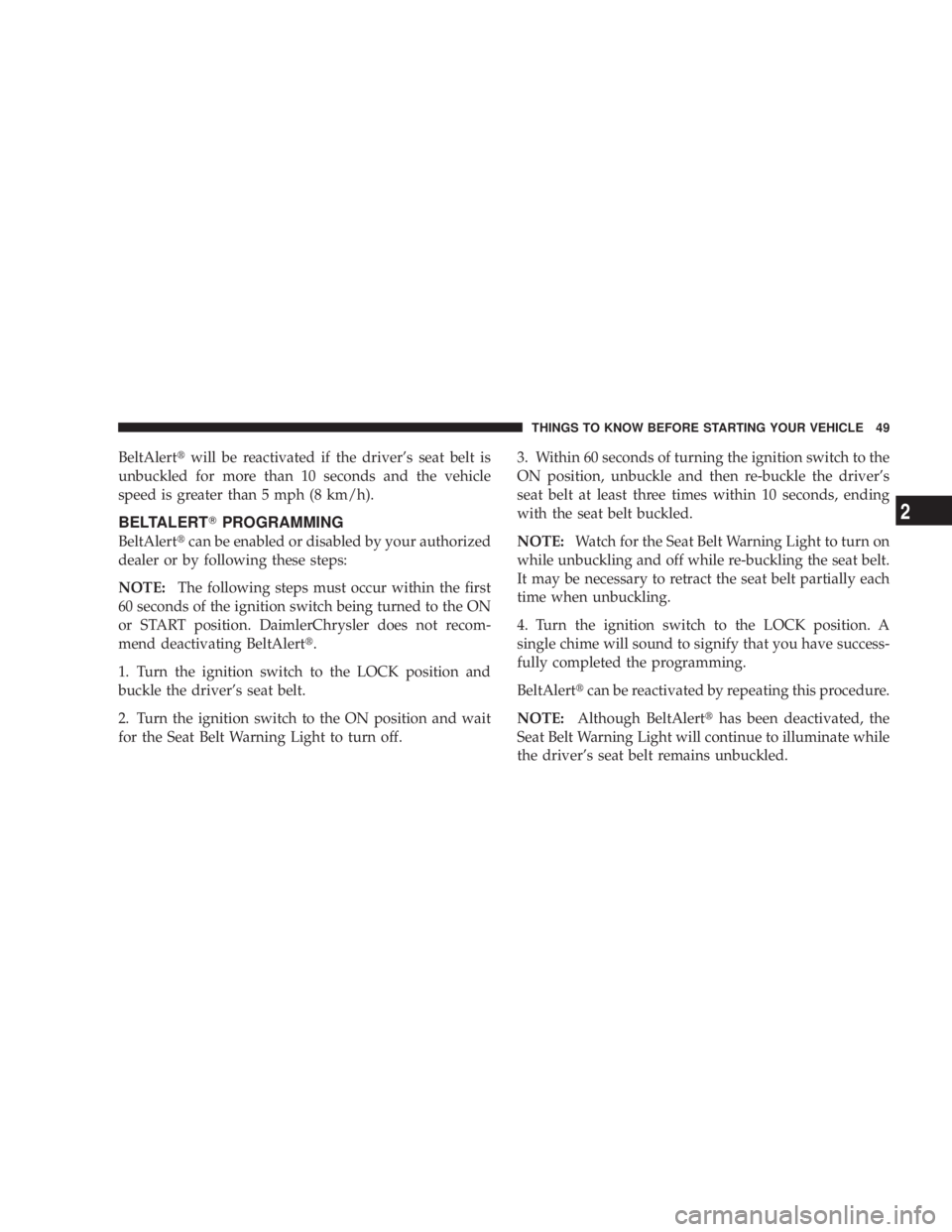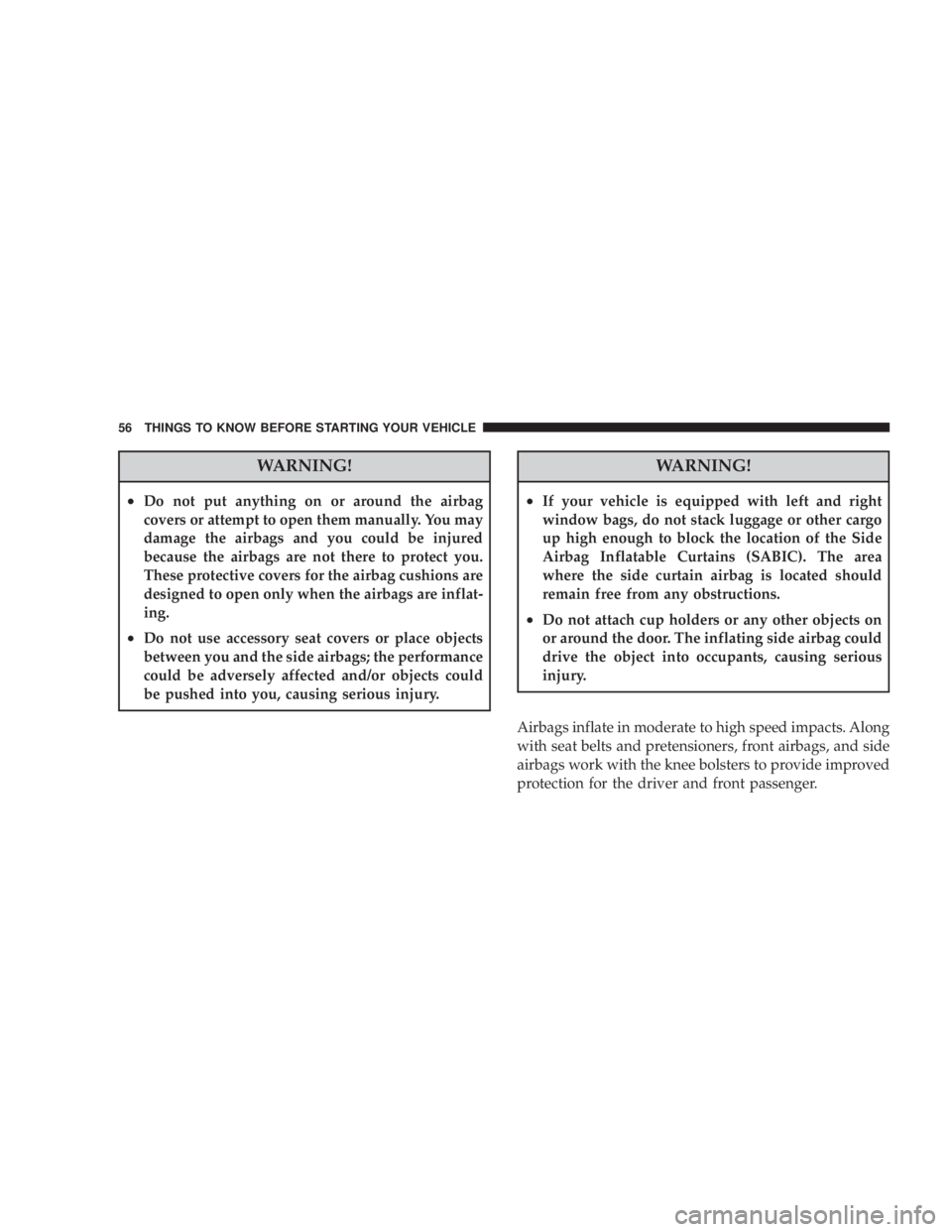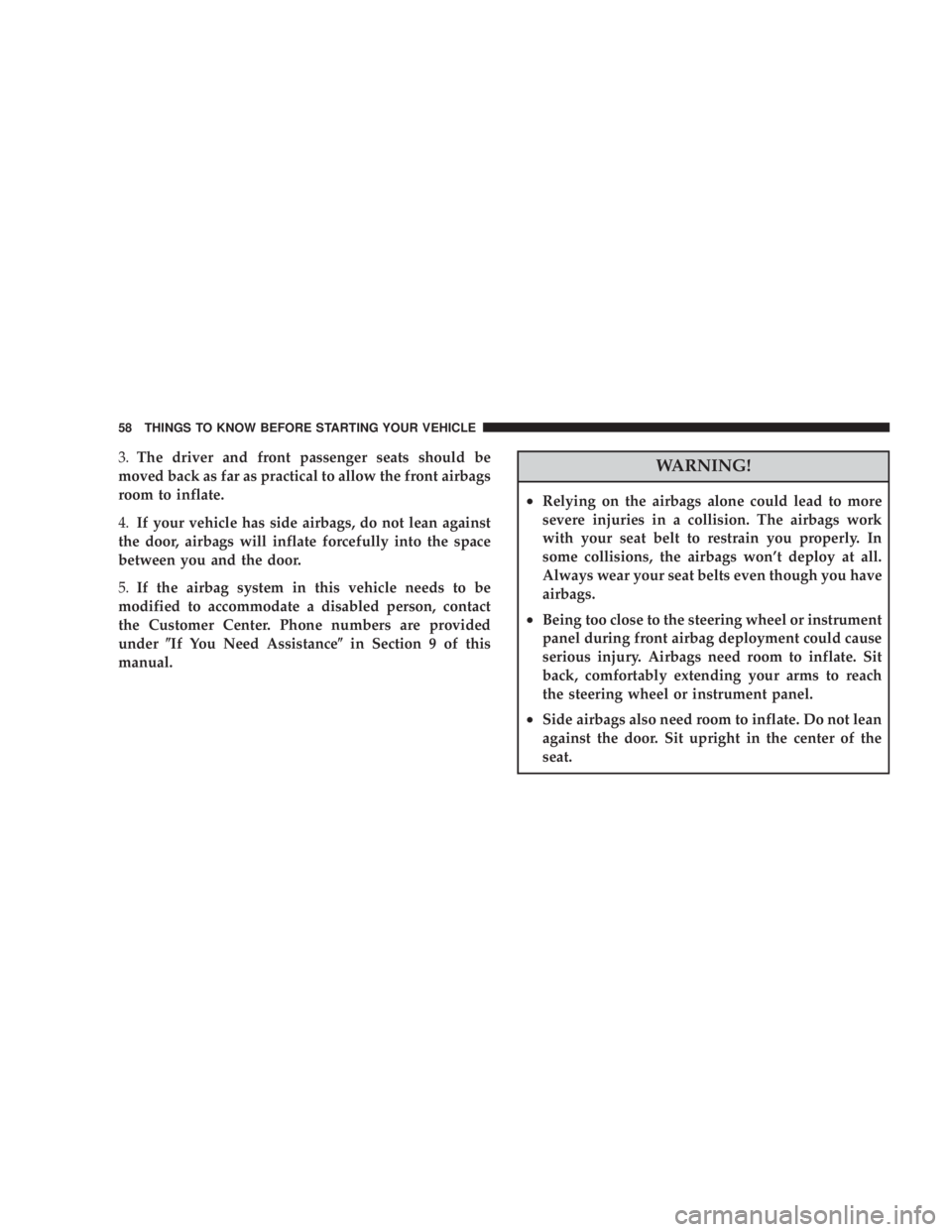Page 47 of 467
WARNING!² A belt that is worn under your arm is very danger-
ous. Your body could strike the inside surfaces of the
vehicle in a collision, increasing head and neck
injury. A belt worn under the arm can cause internal
injuries. Ribs aren't as strong as shoulder bones.
Wear the belt over your shoulder so that your stron-
gest bones will take the force in a collision.
² A shoulder belt placed behind you will not protect
you from injury during a collision. You are more
likely to hit your head in a collision if you do not
wear your shoulder belt. The lap and shoulder belt
are meant to be used together. 4. Position the lap belt across your thighs, below your
abdomen. To remove slack in the lap belt portion, pull up
on the shoulder belt. To loosen the lap belt if it is too tight,
tilt the latch plate and pull on the lap belt. A snug belt
reduces the risk of sliding under the belt in a collision.
Positioning the Lap BeltTHINGS TO KNOW BEFORE STARTING YOUR VEHICLE 45
2
Page 48 of 467

WARNING!² A lap belt worn too high can increase the risk of
internal injury in a collision. The belt forces won't be
at the strong hip and pelvic bones, but across your
abdomen. Always wear the lap belt as low as pos-
sible and keep it snug.
² A twisted belt can't do its job as well. In a collision,
it could even cut into you. Be sure the belt is straight.
If you can't straighten a belt in your vehicle, take it to
your dealer and have it fixed.
5. Position the shoulder belt on your chest so that it is
comfortable and not resting on your neck. The retractor
will withdraw any slack in the belt. 6. To release the belt, push the red button on the buckle.
The belt will automatically retract to its stowed position.
If necessary, slide the latch plate down the webbing to
allow the belt to retract fully.
WARNING!A frayed or torn belt could rip apart in a collision and
leave you with no protection. Inspect the belt system
periodically, checking for cuts, frays, or loose parts.
Damaged parts must be replaced immediately. Do
not disassemble or modify the system. Seat belt
assemblies must be replaced after a collision if they
have been damaged (bent retractor, torn webbing,
etc.).
Lap/Shoulder Belt Untwisting Procedure
Use the following procedure to untwist a twisted lap/
shoulder belt.46 THINGS TO KNOW BEFORE STARTING YOUR VEHICLE
Page 50 of 467

REAR SEAT BELTS
Three point belts are nonadjustable for outboard and
center rear passengers on sedans. The center belt is
mounted to the rear shelf panel and exits through a bezel
in the panel.
SEAT BELT PRETENSIONERS
The seat belts for both front seating positions are
equipped with pretensioning devices that are designed to
remove slack from the seat belt in the event of a collision.
These devices improve the performance of the seat belt
by assuring that the belt is tight about the occupant early
in a collision. Pretensioners work for all size occupants,
including those in child restraints.
In addition, the front passenger seat belt includes a
two-stage load-limiting feature to enhance occupant pro-
tection for the same reason. NOTE: These devices are not a substitute for proper seat
belt placement by the occupant. The seat belt still must be
worn snugly and positioned properly.
The pretensioners are triggered by the Occupant Re-
straint Controller (ORC) (see Airbag Section). Like the
front airbags, the pretensioners are single use items. After
a collision that is severe enough to deploy the airbags and
pretensioners, both must be replaced.
ENHANCED SEAT BELT REMINDER SYSTEM
(BELTALERT T )
If the occupied driver's seat belt has not been buckled
within 60 seconds of starting the vehicle and if the vehicle
speed is greater than 5 mph (8 km/h), BeltAlert t will
alert the driver to buckle their seat belt. The driver
should also instruct all other occupants to buckle their
seat belts. Once the warning is triggered, BeltAlert t will
continue to chime and flash the Seat Belt Warning Light
for 96 seconds or until the driver's seat belt is buckled.48 THINGS TO KNOW BEFORE STARTING YOUR VEHICLE
Page 51 of 467

BeltAlert t will be reactivated if the driver's seat belt is
unbuckled for more than 10 seconds and the vehicle
speed is greater than 5 mph (8 km/h).
BELTALERT T PROGRAMMING
BeltAlert t can be enabled or disabled by your authorized
dealer or by following these steps:
NOTE: The following steps must occur within the first
60 seconds of the ignition switch being turned to the ON
or START position. DaimlerChrysler does not recom-
mend deactivating BeltAlert t .
1. Turn the ignition switch to the LOCK position and
buckle the driver's seat belt.
2. Turn the ignition switch to the ON position and wait
for the Seat Belt Warning Light to turn off. 3. Within 60 seconds of turning the ignition switch to the
ON position, unbuckle and then re-buckle the driver's
seat belt at least three times within 10 seconds, ending
with the seat belt buckled.
NOTE: Watch for the Seat Belt Warning Light to turn on
while unbuckling and off while re-buckling the seat belt.
It may be necessary to retract the seat belt partially each
time when unbuckling.
4. Turn the ignition switch to the LOCK position. A
single chime will sound to signify that you have success-
fully completed the programming.
BeltAlert t can be reactivated by repeating this procedure.
NOTE: Although BeltAlert t has been deactivated, the
Seat Belt Warning Light will continue to illuminate while
the driver's seat belt remains unbuckled. THINGS TO KNOW BEFORE STARTING YOUR VEHICLE 49
2
Page 53 of 467

Seat Belt Extender
If a seat belt is too short, even when fully extended and
when the adjustable upper shoulder belt anchorage (if
equipped) is in its lowest position, your dealer can
provide you with a seat belt extender. This extender
should be used only if the existing belt is not long
enough. When it is not required, remove the extender,
and stow it.
WARNING!Using a seat belt extender when not needed can
increase the risk of injury in a collision. Only use
when the lap belt is not long enough when it is worn
low and snug, and in the recommended seating
positions. Remove and store the extender when not
needed. SUPPLEMENTAL RESTRAINT SYSTEM (SRS) -
AIRBAG
This vehicle has airbags for both the driver and front
passenger as a supplement to the seat belt restraint
systems. The driver's front airbag is mounted in the
center of the steering wheel. The passenger's front airbag
is mounted in the instrument panel, above the glove
compartment. The words SRS AIRBAG are embossed on
the airbag covers. THINGS TO KNOW BEFORE STARTING YOUR VEHICLE 51
2
Page 58 of 467

WARNING!² Do not put anything on or around the airbag
covers or attempt to open them manually. You may
damage the airbags and you could be injured
because the airbags are not there to protect you.
These protective covers for the airbag cushions are
designed to open only when the airbags are inflat-
ing.
² Do not use accessory seat covers or place objects
between you and the side airbags; the performance
could be adversely affected and/or objects could
be pushed into you, causing serious injury. WARNING!² If your vehicle is equipped with left and right
window bags, do not stack luggage or other cargo
up high enough to block the location of the Side
Airbag Inflatable Curtains (SABIC). The area
where the side curtain airbag is located should
remain free from any obstructions.
² Do not attach cup holders or any other objects on
or around the door. The inflating side airbag could
drive the object into occupants, causing serious
injury.
Airbags inflate in moderate to high speed impacts. Along
with seat belts and pretensioners, front airbags, and side
airbags work with the knee bolsters to provide improved
protection for the driver and front passenger.56 THINGS TO KNOW BEFORE STARTING YOUR VEHICLE
Page 60 of 467

3. The driver and front passenger seats should be
moved back as far as practical to allow the front airbags
room to inflate.
4. If your vehicle has side airbags, do not lean against
the door, airbags will inflate forcefully into the space
between you and the door.
5. If the airbag system in this vehicle needs to be
modified to accommodate a disabled person, contact
the Customer Center. Phone numbers are provided
under ( If You Need Assistance ( in Section 9 of this
manual. WARNING!² Relying on the airbags alone could lead to more
severe injuries in a collision. The airbags work
with your seat belt to restrain you properly. In
some collisions, the airbags won't deploy at all.
Always wear your seat belts even though you have
airbags.
² Being too close to the steering wheel or instrument
panel during front airbag deployment could cause
serious injury. Airbags need room to inflate. Sit
back, comfortably extending your arms to reach
the steering wheel or instrument panel.
² Side airbags also need room to inflate. Do not lean
against the door. Sit upright in the center of the
seat.58 THINGS TO KNOW BEFORE STARTING YOUR VEHICLE
Page 61 of 467

AIRBAG DEPLOYMENT SENSORS AND
CONTROLS
Occupant Restraint Controller (ORC)
The Occupant Restraint Controller System (ORC) is
part of a Federally regulated safety system required for
this vehicle.
The ORC determines if a frontal collision is severe
enough to require the airbags to inflate. Based on the
sensor signals, a central electronic Occupant Restraint
Controller (ORC) deploys the front airbags, side inflat-
able airbag curtains (if equipped), seat-mounted side
(Thorax) airbags (if equipped), and front seat belt preten-
sioners as required for each type of impact.
The ORC monitors the readiness of the electronic parts of
the system whenever the ignition switch is in the START
or RUN positions. These include all of the items listed
above except the steering wheel and column, instrument
panel, and passenger knee bolsters. If the key is in the OFF position, in the ACC position, or not in the ignition,
the airbags are not on and will not inflate.
The ORC contains a backup power supply system that
will deploy the airbags even if the battery loses power or
it becomes disconnected prior to deployment.
Also, the ORC turns on the Airbag Warning
Light in the instrument panel for 6 to 8 seconds
for a self-check when the ignition is first turned
on. After the self-check, the Airbag Warning
Light will turn off. If the ORC detects a malfunction in
any part of the system, it turns on the Airbag Warning
Light either momentarily or continuously. A single chime
will sound if the light comes on again after initial start
up.
It also includes diagnostics that will illuminate the instru-
ment cluster Airbag Warning Light if a malfunction is
noted. The diagnostics also record the nature of the
malfunction. THINGS TO KNOW BEFORE STARTING YOUR VEHICLE 59
2